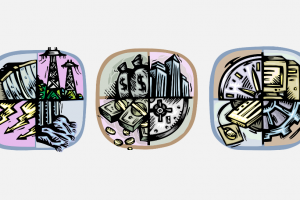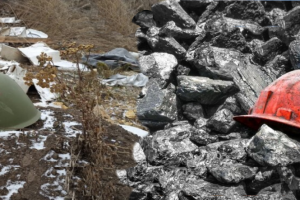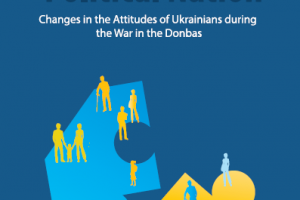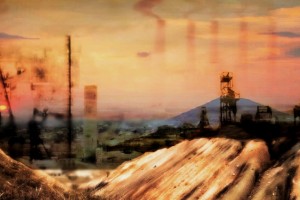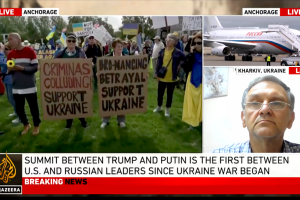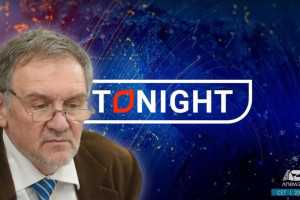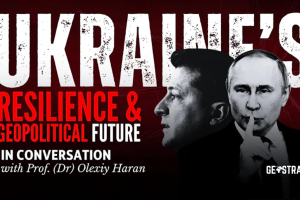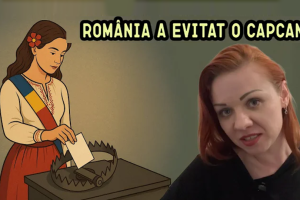After the Euromaidan revolution and Russia’s annexation of Crimea and covert war in Eastern Ukraine, Ukraine launched a rapid de-Sovietization course, aiming to do away with historical myths tying it to the aggressor country and construct a new historical narrative. Six years later, Soviet stereotypes are much less influential, but some are still widespread, a poll conducted by the Ilko Kucheriv Democratic Initiatives Foundation reveals. Conducted on the anniversary of Victory Day, the poll looks into Ukrainians’ perceptions of the cornerstone myth of modern Russia, the “Great Patriotic War,” which is how the USSR called the period of WWII after the German attack in 1941 despite the Molotov-Ribbentrop Peace Pact. The poll found that most Ukrainians believe the USSR shared responsibility for starting WWII with Nazi Germany, but at the same time viewed Victory Day as a victory of the Soviet people in the “Great Patriotic War.”
What is it now for Ukrainians, World War II, or the Great Patriotic War? Do they mark Victory Day like in Russia or Day of Remembrance and Reconciliation like in the rest of Europe? Do they believe that the Soviet Union was also responsible for the start of World War II?
 These are some of the questions that Olexiy Haran, Research Director at the Democratic Initiatives Foundation, asked when presenting the results of the poll at the Chatham House event “Victory and Memory: WW2 Narratives in Modern Day Russia and Ukraine” on 11 May, looking into how adopted decommunization laws have impacted Ukrainians’ views of the war. The graphs in this report are from his presentation.
These are some of the questions that Olexiy Haran, Research Director at the Democratic Initiatives Foundation, asked when presenting the results of the poll at the Chatham House event “Victory and Memory: WW2 Narratives in Modern Day Russia and Ukraine” on 11 May, looking into how adopted decommunization laws have impacted Ukrainians’ views of the war. The graphs in this report are from his presentation.
Four such laws adopted in 2015 laid down the foundation for its “decommunization” measures. “On the Legal Status and Honoring the Memory of Fighters for Ukraine’s Independence in the Twentieth Century” elevated the status of, notably, fighters of the Ukrainian Insurgent Army. “On Perpetuation of the Victory over Nazism in World War II of 1939-1945” introduced the usage of the term “Second World War” instead of the Soviet “Great Patriotic War” and introduced a day of memory and reconciliation on 8 May along with the rest of Europe, apart from Victory Day on 9 May. “On access to Archives of Repressive Agencies of Totalitarian Communist Regime of 1917-1991” declassified materials on KGB repressions and opened the archives to the public. And “On the condemnation of the communist and national socialist (Nazi) regimes, and prohibition of propaganda of their symbols” laid down the foundation of Ukraine’s “Leninfall,” or dismantling of Soviet monuments and establishing criminal responsibility for propaganda of the Communist and Nazi regimes.
In 2017, Ukraine made another step away from the Russian narrative of the “Great Patriotic War” by banning the St. George’s ribbon, a controversial emblem of the Second World War used in Russia in commemorations of the victory over Nazism which many Ukrainians see as a symbol of ongoing Russian aggression. The poppy was promoted as a symbol of Victory Day instead.
These legal steps, together with the realities of Russia’s war against Ukraine, have brought results. On the eve of the 75th anniversary of victory over Nazism in WWII, Ukrainian society is gradually turning away from myths of Soviet and Russian propaganda and grows more and more aware of Ukraine’s own role in those events.
Importantly, 56% of Ukrainians agree with the statement that the Soviet Union, together with Germany, are responsible for the beginning of World War II, 24% disagree with this, and another 20% are undecided. Regarding this statement, there are no cardinal differences between all age groups for up to 70 years. Regional differences constitute up to 19% (63% in the West agree with this statement as well as 44% in the East).
This result shows that Ukrainians are slowly moving away from the Soviet interpretation of events, in which the collaboration of the USSR and Nazi Germany in the Molotov-Ribbentrop pact was kept secret. Modern-day Russia had until recently denied the existence of this document altogether.
Regarding the celebration of Victory Day, Ukrainians are much less clear-cut. About 52% of citizens adhere to the Soviet interpretation that Victory Day is primarily a celebration of the victory of the Soviet people in the “Great Patriotic War.” Only 32% consider this date as a day to celebrate the victory of the anti-Hitler coalition in World War II and the contribution of the Ukrainian people. For 6%, this day is just an extra day off. Among youth, there are slightly more indifferent people, and among people over the age of 70, there is much more support for the Soviet interpretation. Moreover, this interpretation is more common for East and South, but the difference compared to the West and the Center remains within 10 – 15%, according to the Democratic Initiatives Foundation.
44% of Ukrainians support the recognition of soldiers of the Ukrainian Insurgent Army (UPA) as fighters for Ukraine’s independence, another 22% are against this decision; for 16%, it is indifferent, and another 17% of respondents are undecided. Unsurprisingly, Western and Central Ukraine are more supportive, while in the South and East respondents were nearly equally split.
During Ukraine’s independence, two common narratives of the Second World War had competed: the Soviet Army and Soviet partisans as those who fought down Nazi Germans and, subsequently, Soviet soldiers portrayed as heroes; and the Ukrainian nationalists, OUN-UPA in particular, who were fighting for the freedom of Ukraine, having some agreements with Germans at the beginning of the War, but later fighting both against Soviet and Nazi armies. Before the Euromaidan revolution, most Ukrainians were against, and in 2017, the ratio of supporters-opposers was 45%-33%. Therefore, we can expect that this question will be a historical memory “battleground” in the near future.
Other important conclusions of the survey are that most Ukrainians (51%) are unaware of “Immortal Regiment” marches– processions on May 9 when marchers hold photos of their relatives taking part in WWII which have been accused of being part of Russia’s hybrid war. Another 12% know about them but treat them negatively. 18% are aware and positive about it, 12% are neutral. In all regions, more than 50% do not know about this event, except for the East, where awareness is slightly higher (33% know nothing). There are also more positive attitudes in the East – 32% against 25% in the South, 15% in the Center, and 9% in the West. This result marks a break between the Ukrainian and Russian media spheres.
Ukrainians were most split about the decision to ban the St. George’s ribbon. About a third of Ukrainians support the decision to ban the St. George ribbon, but about a third do not. 25% of respondents are indifferent to this. The most significant share of supporters of this decision has been observed in the West (44% support, 23.2% do not support), in the Central region opinions are divided in half (30-31 %), the least supporters – in the South and East (about 20% support this decision, 40 % are against it).
“We really see a lot of positive things, including in eastern Ukraine. I think this is worth emphasizing. Because it was impossible to imagine 10-20 years ago that the recognition of the Ukrainian Insurgent Army fighters as fighters for Ukraine’s independence would be at 30%, that the majority would consider the USSR responsible for the beginning of World War II and support the refusal of Ukrainian politicians to take part in the parade in Moscow. We have to view this as a positive thing.
In some things, we saw a compromise typical of Ukrainians. For example, when asked whether to celebrate the eighth or ninth of May, people answer in typically Ukrainian fashion – both the eighth and the ninth. Unfortunately, there are questions where we still see the influence of Soviet propaganda. After the Revolution of Dignity and Russian aggression, many problems became clearer to Ukrainians. If earlier for them the words ‘Russian aggression’ were something abstract, now it has become absolutely concrete. People connect the present and the past and it has become easier for them to make sense of the past. At that time [after Euromaidan- Dd], it contributed to a colossal breakthrough in the historical memory of Ukrainians. And now [after Zelenskyy’s election- Ed.] we see a slightly different atmosphere, at least at the highest levels of government. When you constantly say ‘there’s no difference,’ it to some extent disorients part of society,” prof. Haran noted in a discussion about the poll.
Source: Euromaidanpress

